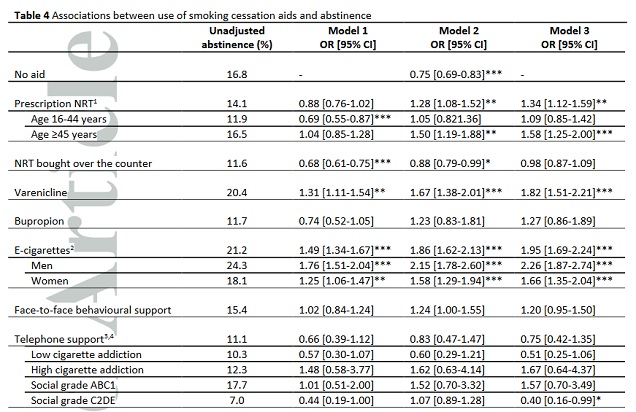
At this point, it’s pretty obvious that vaping helps smokers quit. Despite this, there are many, many claims to the contrary – from the almost-sensible point that we need a bit more data first to the outright absurd proposition that they actually reduce your odds of quitting.
A previous post laid out the evidence as it stands and made the case that the best you can do to argue otherwise is claim that full randomized controlled trials are the only type of evidence worth listening to. They’re great when it comes to eliminating as much potential bias as possible from a result, but it’s beyond naïve to pretend they’re the only thing you should pay attention to.
So a new study from the UK using real-world data to look at a whole host of approaches to quitting smoking, including vaping, is not something you should brush off lightly. With a sample size of almost 19,000 (and 2,400 using vaping to quit) and a look at how things actually play out in practice, it won’t be an easy one for the detractors to ignore.
And the results speak volumes: the smokers who tried to quit by vaping were more likely to quit than those who used Chantix, patches, gums, bupropion or any of the studied approaches.
The Study: How Effective Are Quitting Methods in the Real World?

The study (you can read it in full here) used data from the Smoking Toolkit Study, which is a national surveillance survey of adults in England with a representative sample. There are regular updates on the website and it’s generally a great place to get up-to-date statistics, but the accumulated data they’ve collected each month since 2006 is a big source of potential information about how smokers try to quit and the effectiveness of different approaches. This study essentially aims to make the most of that resource, with data running from November 2006 to July 2018.
The researchers looked at the data from the smokers who smoked cigarettes or another tobacco product (either daily or occasionally) and made a quit attempt in the year prior to the survey. The researchers split the quit attempts into ones using nicotine replacement therapy (NRT, like patches and gums) on prescription or over-the-counter, varenicline (Chantix), bupropion (WellButrin), vaping, face-to-face behavioral support, phone support (i.e. quitlines), websites, written self-help materials and hypnotherapy. They looked at which approaches the smokers used to quit and counted a success as anybody who hadn’t smoked since the last time they tried to quit.
Because the study was conducted by survey, they couldn’t verify that the participants really had quit with lab tests, but generally speaking people are less likely to lie in population-level surveys than strict clinical trials so this shouldn’t cause an issue with the results.
The researchers looked at other factors in the analysis, too. For example, they took into account the level of smokers’ addictions, how long ago the quit attempt started, how many quit attempts they had in the past year, some demographic characteristics (e.g. age or socioeconomic status) and a few other factors (such as the time of year the attempt took place in, e.g. the surge in the new year). The researchers analyzed the data using four models, which looked at the data in different ways – e.g. adjusting for use of multiple quitting methods, adjusting for other factors without taking into account multiple approaches and adjusting for both – to get a broader picture of what’s going on.
The Results: Vaping Tops All Other Quitting Methods

The headline finding is that vaping was the most effective method for quitting after adjusting for multiple approaches being used and other relevant factors, with varenicline (Chantix) also performing better than quitting with no aid.
In terms of raw percentages, around 21 percent of those using e-cigs quit successfully, compared to 20 percent of Chantix users and 19 percent of those who used websites. Everything other method scored lower than these, but it’s worth noting that unassisted quitting was successful 17 percent of the time in the study.
But these figures don’t take account for all of the other factors. When researchers did this, they found that vaping increased your odds of quitting by 95 percent (i.e. almost double the chance), using Chantix by 82 percent, and websites no longer made a significant difference. However, in the adjusted model, NRT given on prescription increased quitting odds by 34 percent on average, but really the difference was confined to older smokers (45 and older), where odds increased 58 percent, while it wasn’t shown to be effective for younger smokers.
Some of the other results varied based on some of the included characteristics. Vaping is included in this too – for some reason that isn’t quite clear, men who vaped were over twice as likely to quit, compared to just a 66 percent increase in women. Websites appeared quite effective for people in low social grades (but not higher ones) and telephone support led to them actually having worse odds. The other models produced slightly different results in some cases but broadly these same findings persisted.
It’s worth stressing that this suggests that using over-the-counter NRT doesn’t increase your odds of quitting compared to not using it – in fact, in simpler models it actually reduced chances of quitting. The same is true for all of the other approaches studied. The authors point out that results of clinical trials tend to be more favorable than the ones found here, but the results of this study were generally in-line with trial data.
How Vaping Makes a Difference: Popularity Matters

Some of the seemingly less interesting data from the study really shows why vaping is a fantastic tool for reducing the number of people who smoke. Even if there was a 100 percent effective quitting method, it wouldn’t help anybody quit if nobody tried it. In fact, even something 1 percent effective would be much more useful in practice if every smoker tried it.
In the study, over the counter NRT was the most commonly-used method (by 27.5 percent of the group), followed by vaping (12.7 percent), prescription NRT (8.5 percent), Chantix (5.5 percent) and face-to-face counseling (4.6 percent). In other words, the most used method of quitting (discounting cold turkey) wasn’t actually effective based on the study. Chantix works, but only 5.5 percent of smokers try it. Vaping, on the other hand, strikes a balance between effectiveness and appeal to a large number of smokers.
For 1,000 smokers trying to quit, the results suggest that 127 would try vaping, and about 27 of them would quit. For Chantix, 55 would try it, and only 11 of them would quit. This simple comparison shows the massive difference something as simple as popularity can make.
And this is why the focus on pure effectiveness rates and clinical trial results really misses the key point. The actual impact of methods for quit smoking is how they affect the real world, i.e. how many smokers quit because of them? This study makes it clear that vaping has the biggest potential to make an impact on that front, and combined with all of the other evidence we have – including clinical trials – still casting doubt on the potential benefits is as dangerous as it is dumb.
The study is far from perfect, of course. For instance, the authors point out that although prescription medications tend to be combined with behavioral support, and this is known to be the most effective approach based on trial data, the current study didn’t look at the effect of combinations of quitting methods. It also didn’t consider the ways different factors could interact to impact effectiveness, for example whether some methods are better than others if you’re low socioeconomic status and highly addicted. But all research has limitations, and provided you keep these factors in mind, this study is very strong evidence that vaping is effective for quitting smoking.
Vaping Works, So Let’s Get Behind It
If you’ve been following the science, this study is not really news. We know vaping works. But the more results like this one hit the journals, and the more we promote results like this that show the huge potential vaping has to reduce the amount of death and suffering caused by smoking, the more chance that legislators around the world will start to take notice. It’s an uphill battle, but every piece of evidence is a valuable weapon in the fight against misinformation.

